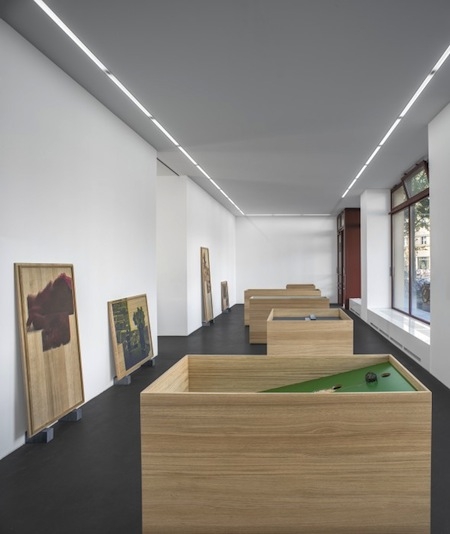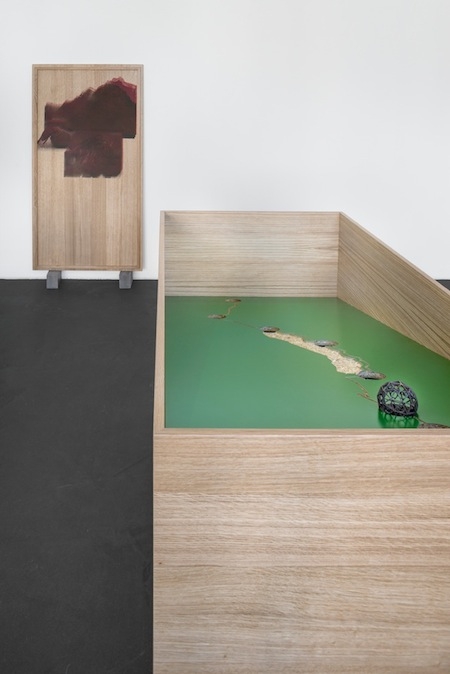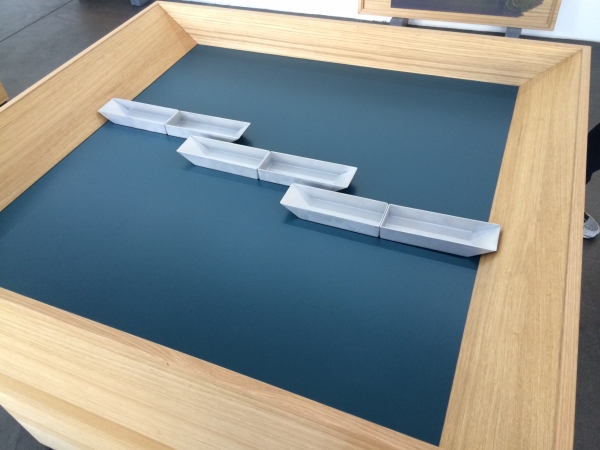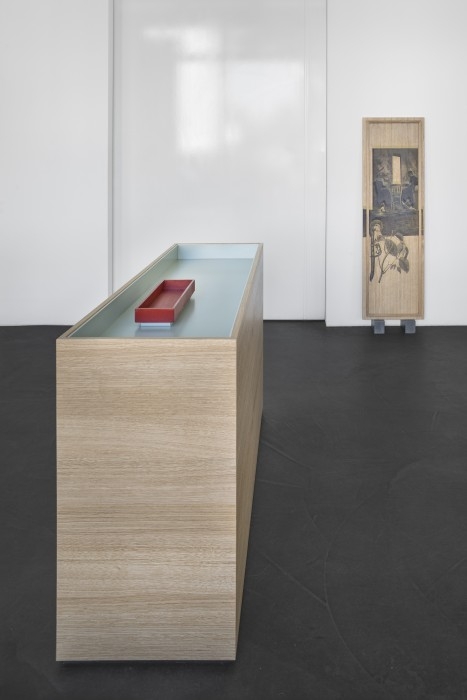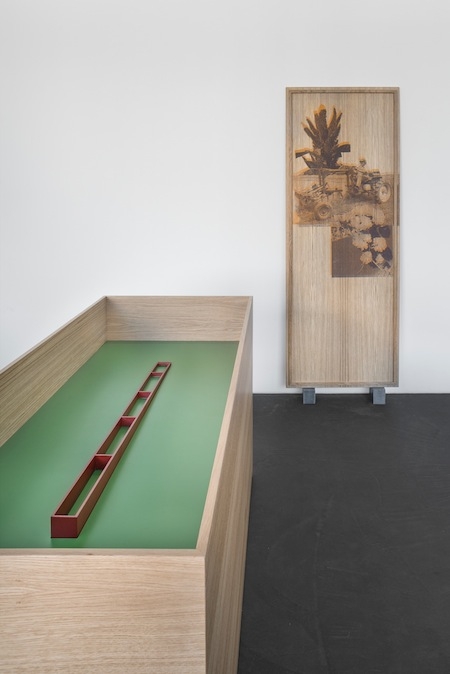
Installation view, closed sculptures, Galerie Nagel Draxler, Berlin, 2014
Installation view, open sculptures, Galerie Nagel Draxler, Berlin, 2014
Installation view, open sculptures, Galerie Nagel Draxler, Berlin, 2014
"Glarus Scraping Ball," 2014
"Swiss Chard Ferry," 2014
"Die Neue Welt," 2014
"Hudson Valley Tastemakers," 2014
"Von der Sehnsucht im Einklang mit der Natur zu leben," 2014
Umsetzungen
18 September – 28 October 2014
Galerie Nagel Draxler, Berlin, Germany
The works of Christian Philipp Müller relate to the sites they are taking place in in a complex way. Their history, their mythological tradition, their geological, urban, architectural and sociological components are material and stage. Müllers’ projects emerge through any by these factors, they are “site-specific.” In many cases they include a performative, ephemeral aspect. Both characteristics are opposed to the commodity character of works of art which require both their durability and their tradability.
In a series of gallery exhibitions, Christian Philipp Müller proceeded in a similar way. "Resolutions" (Galerie Christian Nagel, Berlin 2008), "Berlin, Deutschland und die Welt" (Galerie Christian Nagel, Berlin 2005), "Imagetransfer" (Galerie Christian Nagel, Cologne 1998) and "Köln–Düsseldorf" (Galerie Christian Nagel, Cologne 1990) were all context-related exhibitions addressing regional or “German” topics and always engaging with the surrounding environment. Müller’s exhibitions can be regarded as cultural critique (in the sense of a self-reflexive artistic practice).
In "Umsetzungen" he moves beyond. By putting sculptural “implementations” onto display, Müller targets the format of the “gallery”, the sales room as strategic centre of the international art business in which price lists are available and offers are being sent out, as such and at a fundamental level.
Five volumes, from the outside opaque minimal sculptures, contain in their insides “implementations” as abstraction and autonomous works. They deal with the following projects (see below detailed descriptions):
– “Glarus Scraping Ball,” Kunsthaus Glarus and Klöntal, Switzerland, 2014
– “Swiss Chard Ferry,” documenta 13, Kassel, Germany, 2012
– “Die Neue Welt,” Kloster Melk, Kloster Park, 2006
– “Hudson Valley Tastemakers,” Bard College Campus, Annandale-on-Hudson, 2003
– “Von der Sehnsucht im Einklang mit der Natur zu leben,” “Projekt Ansitz Löwengang,” Alois Lageder, Margreid, Bozen, Italy, 2001
All projects have landscapes as backgrounds and appear to be untransferable from their locations. It is in particular the projects that are beyond object character and commercial usability that Müller transforms into “elegant” works of art by using precious materials (such as bronze, steel, glass, etc.) and without organic additions. The core of the exhibition lies in this gesture and not necessarily in the contentuality of the sculptures. By shifting the formats within the field of art, Müller exhibits “site specificity” in reverse and addresses the “art-place” (the gallery as sales room) specifically as such. Thus, the contentuality is importantant, because it brings differentiation into the field of art and is not aided by claims from the outside, as in site-specific projects of “first degree,” but rather is used by Müller as a pre-existing “transformed” material.
The oak wood, of which the five volumes are made, conveys a sense of stability and dignity. Müller’s "Umsetzungen" are sculptural nested structures of bourgeois institutions of art and their systems of values.
Prior installations:
Glarus Scraping Ball
Performance and Installation with Video
24 May – 14 September 2014
Kunsthaus Glarus and Klöntal Valley, Switzerland
The performative sculpture "Glarus Scraping Ball" (2014) combines botany, geology, traditional myths, an old recipe for a Glarus tea, and locally rooted art history. On walks, for example with botanical experts, visitors are transformed into actors: somewhere along the way between Bödmerenwald and Kunsthaus Glarus, they come across a permeable metal mesh ball and are invited to start it rolling with a little push, moving it on their way through a stretch of landscape marked with signs. Thus, in the search for ingredients for a Glarus tea recipe from the eighteenth century, it rolls through many layers of civilization, witnessing numerous things along the way: flowers, earth, stones, and roots. Christian Philipp Müller is also producing a talisman, titled "Vreneli’s Talisman" (2014), which is filled with the dried root of the Devil’s bit — one of the ingredients of the tea recipe — and also references the legend of Vrenelisgärtli in the Glärnisch mountains in which a headstrong young woman seeks to start a garden in an almost impossible to reach spot, losing her life in the process. Both curators wear this talisman during the Klöntal Triennale in a kind of performative action, thereby communicating to the world the protective effect, according to tradition, of the Glarus root.
Swiss Chard Ferry
documenta 13, Kassel, Germany, 2012
For “Swiss Chard Ferry, The Russians aren’t going to make it across the Fulda River any more” Müller planted 60 varieties of colorful chard (Beta vulgaris), collected with the help of David Kottis from various seed banks worldwide. The plants were placed on six barges in 66 crates, of which 60 contained single varieties and six a mix of Swiss chard from Switzerland, Turkey, Cuba, Israel, China and India, among other places.
The barges are units made of standard pontoons, dating from the Cold War and lent for the 100 days of d13 from the THW (Technischer Hilfs-Dienst), the official Federal German Technical Relief Organization for Water-Hazards. The vernacular aesthetic referred to post-disaster devices as well as to the boat that ferried visitors to nearby Siebenbergen Island until the mid 1950s.
“Swiss Chard Ferry” was a metaphorical bridge between different realms — and formed a temporary shortcut between pedagogy and pleasure — between the School for Art and Design Kassel and the Historic Pleasure Garden Karlsaue, dating from the 17th century. The hybrid mobile sculpture combined minimal high-technology with a colorful array of edible vegetables realized in collaboration with the Department of Organic Agricultural Sciences of the University of Kassel in Witzenhausen.
The project also involved the participation of visitors who were invited to taste the chard and explore the connections between names like “Pot of Gold” and “Pink Lipstick” and their country of origin.
The temporary bridge became a ferry three times during the Preview of d13 and during the tasting events on July 28 and September 15, 2012, which were positioned adjacent to the ferry. “Swiss Chard Ferry Tasting” was the activation of Christian Philipp Müller’s project for dOCUMENTA (13), which consisted of turning six barges from the Cold War into floating Swiss chard gardens. By means of the sixty different varieties of Swiss chard grown on them, the ferries were given a new life, bringing forth a historical, environmental, and culinary narrative. During two chard tasting experiences, over 700 visitors attended. Twenty of the sixty varieties of chard were lightly sautéed to be tasted on their own and ten international recipes featuring chard were also presented. Members of the Agricultural Department of the University of Kassel gave a presentation on biodiversity, and Müller discussed the historical and artistic dimensions of his project.
Die Neue Welt
Melk Monastery, Monastery Park, 2006
(a project in conjunction with “Art in Public Space,” Lower Austria)
– Die Neue Welt, 2006, steel, cement base, earth, seasonal plantings; 27 x 301 x 92 inches
In honor of the Mozart Year 2006, Christian Philipp Müller was invited to design a work of art for the Baroque Garden of the Benedictine abbey Stift Melk in Austria; the work was intended to shed new light on the historical circumstances under which the Wunderkind Wolfgang Amadeus Mozart performed in the abbey and was then summoned to dine with the abbot in 1767 and 1768. On the top terrace of the newly restored garden, Müller erected a sculpture that explores the themes of change, exchange, and taste. His research in the monastic library into the origin and spread of vegetables and fruit imported into Austria from the New World had revealed that in the eighteenth century, for example, the flowers of tomato and potato plants were used merely as hair ornaments for noble ladies, whereas the tomatoes and potatoes themselves were deemed too poisonous for human consumption. Leopold and Amadeus Mozart had eaten their first potatoes while in London in 1764, however (and hence), long before their visit to Stift Melk. That same year, Johann Bergl completed his bacchanalian paintings of the New World in the Pleasure Pavilion there, unveiling what, at least for the monks, was an unattainable, paradisiacal life.
After long periods of fasting and bloodletting, the monks were prescribed a sojourn in the Pleasure Pavilion on the assumption that the splendid frescoes of distant lands to be seen there would restore their health. Müller translated the Baroque opulence of the paintings into the three-dimensional reality of the Abbey Garden’s rectangular pond. After placing a steel bath of the same proportions in the golden section of the pond, meaning, asymmetrically in relation to its central axis, he immediately set about turning it into a locus amoenus of the New World. At the end of August 2006, Müller celebrated a harvest thanksgiving, commemorating the gifts the Indians had presented to the newcomers from the Old World upon their arrival in 1621 — gifts that undoubtedly saved them from starvation. More than a hundred guests were invited to this event and treated to dishes composed of historical, locally grown varieties of amaranth, beans, Indian corn, potatoes, bell peppers, and tomatoes.
Hudson Valley Taste Makers
Campus Bard College, Annandale-on-Hudson, 2003
– Hudson Valley Tastemakers, 2003, steel, painted; six different types of soil from the Hudson Valley, seasonal plantings; 59 x 1181 x 47 inches
– Watershed Tastemakers, three dinners at different locations: Chef Gray Kunz and his crew at Dick’s Castle, 2002; Chef Mary Cleaver at Bear Mountain Inn, 2003; Chef Peter Hoffman at Glynwood Center, 2004
Watershed is the name of a project initiated by Diane Shamash (Minetta Brook) in the Hudson Valley near New York. There, since May 2002, ten international artists have created conceptual works of art exploring the natural and cultural geography of the Hudson River. The year 2003 saw several important cultural institutions putting down roots here: Frank Gehry built a music theater for Bard College in Annandale-on-Hudson, and the Dia Center for the Arts moved into an old factory with 300,000 square meters of space in Beacon. This development was to have far-reaching consequences for the unstable economic situation of this area, which, since the demise of the brick-making and textiles industries, has been primarily dependent on tourism.
Hudson Valley Tastemakers is an earth sculpture erected by Christian Philipp Müller on the campus of Bard College. A thirty-meter long steel tub projects out of the earth like a wedge pointing towards the Catskill Mountains in the far distance. The tub has been partitioned into six separate plots, each sown with plants in the same relative proportion as those found on county farms of Putnam, Greene, Ulster, Orange, Dutchess, and Columbia in New York State. The seasonal variations in what the plots contain reflect a dialogue with local farmers on the potential of the soil and the microclimate of the valley. In search of a new, or perhaps a long forgotten taste of the Hudson Valley, Müller collected regional recipes, talked to farmers and innovative cooks as well.
In conjunction with his Hudson Valley Tastemakers, Müller also initiated three banquets: in 2002, with Gray Kunz at Dick’s Castle, in 2003, with Mary Cleaver at the Bear Mountain Lodge, and in 2004, with Peter Hoffman at the Glynwood Center. There are now plans for a cookbook featuring the recipes and the biographies of the Hudson Valley farmers and New York’s top chefs, together with views of the sculpture in each season.
Von der Sehnsucht im Einklang mit der Natur zu leben
(On the Longing to Live in Harmony with Nature”)
“Projekt Ansitz Löwengang”, Alois Lageder, Margreid, Bozen, Italien, 2001
Quote from the Alois Lageder website:
Christian Philipp Müller was particularly fascinated, in the course of a conversation, by Alois Lageder’s assertion that the quality of a wine is determined in the vineyard, and not in winery cellars. So Müller went out to visit them to get to know the place where the whole process begins. His work is entitled “On the Longing to Live in Harmony with Nature” and presents itself as a homage to Mother Earth, who lavishes such great gifts on the human being.
Three free-standing glass cubes filled with soil from the finest exposures of the Alois Lageder vineyards:
Chalk and moraine from Magrè, where grapes are grown for Löwengang Chardonnay; and clay and loam from Römigberg, up above the Lake of Caldaro, where Cor Römigberg ripens. Fine loess from Lindenburg, near Bolzano, the home of Lagrein. Growing from the cubes of earth are ivy, grasses, and stinging nettle, just as in the vineyards. Because the Alois Lageder vineyards are rich with plants like these, as a vital, viable environment for useful fauna and insects, which largely discount the need for synthetic means of grape protection.
On the one hand, the work finds its theme in Alois Lageder’s commitment to natural equilibriums: he has always rejected one-crop agriculture and defended the planting of numerous varieties of grapes. And on the other it brings a piece of nature into the winery’s offices.

